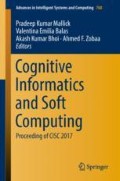Abstract
Brain–Computer Interface (BCI) provides an alternative way for humans to communicate with the external environment. BCI systems can be of great help to people with severe motor disabilities who cannot perform normal daily activities. In this paper, we introduce a novel steady-state visual evoked potential (SSVEP)-based brain–computer interface system that control home appliances like electric fan, tube light, etc. Designed system aim is to extract the SSVEP signal and then classify them using PCA. We confirmed the generation of SSVEP frequencies in the online analysis using Fast Fourier Transform. The classification of SSVEP signals is done using Principal Component Analysis.
Access this chapter
Tax calculation will be finalised at checkout
Purchases are for personal use only
References
McFarland, D.J., Wolpaw, J.R.: Brain-computer interfaces for communication and control. Commun. ACM 54(5) (2011)
Fazel-Rezai, R., et al.: P300 brain computer interface: current challenges and emerging trends. Frontiers Neuroeng. 5, 14 (2012)
Joshi, R., Saraswat, P., Gajendran, R.: A novel mu rhythm-based brain computer interface design that uses a programmable system on chip. J. Med. Signals Sens. 2(1), 11 (2012)
Neuper, C., Muller-Putz, G.R., Scherer, R.: Motor imagery and EEG-based control of spelling devices and neuroprostheses. Prog. Brain Res. 159, 393–409 (2006)
Muller-Putz, G.R., Scherer, R., Neuper, C.: Steady-state somatosensory evoked potentials: suitable brain signals for brain-computer interfaces? IEEE Trans. Neural Syst. Rehabil. Eng. 14(1) (2006)
Kaufmann, T., Herweg, A., Kübler, A: Toward brain-computer interface based wheelchair control utilizing tactually-evoked event-related potentials. J. NeuroEng. Rehabil. 11(1), 7 (2014)
Kaongoen, N., Jo, S.: A novel hybrid auditory BCI paradigm combining ASSR and P300. J. Neurosci. Methods 279, 44–51 (2017)
Norcia, A.M., et al.: The steady-state visual evoked potential in vision research: a review. J. Vision 15(6), 4 (2015)
Morris, J., Holcomb, P.J.: Effects of spatial selective attention on the steady-state visual evoked potential in the 20–28 Hz range. Brain Res. Cogn. Brain Res. 25(3) (1998)
Movahedi, M.M., Mehdizadeh, A., Alipour, A.: Development of a Brain Computer Interface (BCI) speller system based on SSVEP signals. J. Biomed. Phys. Eng. 3(3) (2013)
Chen, X., Chen, Z.: A high-ITR SSVEP-based BCI speller. Brain-Comput. Interfaces (Taylor & Franics Online) 1 (2014)
Zhu, D., Bieger, J.: A survey of stimulation methods used in SSVEP-based BCIs. Comput. Intell. Neurosci. 2010, Article ID 702357, 12 (2010)
Myslobodsky, M.S.; Coppola, R., Bar-Ziv, J., Weinberger, D.R.: Adequacy of the international 10–20 electrode system for computed neurophysiologic topography. J. Clin. Neurophysiol. 7, 507–518 (1990)
Zifkin, B.G., Inoue, Y.: Visual reflex seizures induced by complex stimuli. Epilepsia 45, 27–29 (2004)
Lin, Z., Zhang, C., Wu, W.: Frequency recognition based on canonical correlation analysis for SSVEP-based BCIs. IEEE Trans. Biomed. Eng. 54(6), 1172–1176 (2007)
Nakanishi, M., et al.: A comparison study of canonical correlation analysis based methods for detecting steady-state visual evoked potentials. In: Yao, D. (ed.) PLoSONE 10(10) (2015)
Wu, Z.: SSVEP extraction based on the similarity of background EEG. In: Di Russo, F. (ed.) PLoS ONE 9(4) (2014)
Jolliffe, I.: Principal Component Analysis. Springer, New York (1986)
Acknowledgements
Authors would like to acknowledge financial assistance from Department of Science and Technology (New Delhi) under Instrument Development Scheme. Author Mr. Noel Tavares would like to thank DST, New Delhi for granting INSPIRE Fellowship to do full time research at Goa University.
Author information
Authors and Affiliations
Corresponding author
Editor information
Editors and Affiliations
Rights and permissions
Copyright information
© 2019 Springer Nature Singapore Pte Ltd.
About this paper
Cite this paper
Tavares, N.G., Gad, R.S. (2019). Steady-State Visual Evoked Potential-Based Real-Time BCI for Smart Appliance Control. In: Mallick, P., Balas, V., Bhoi, A., Zobaa, A. (eds) Cognitive Informatics and Soft Computing. Advances in Intelligent Systems and Computing, vol 768. Springer, Singapore. https://doi.org/10.1007/978-981-13-0617-4_74
Download citation
DOI: https://doi.org/10.1007/978-981-13-0617-4_74
Published:
Publisher Name: Springer, Singapore
Print ISBN: 978-981-13-0616-7
Online ISBN: 978-981-13-0617-4
eBook Packages: Intelligent Technologies and RoboticsIntelligent Technologies and Robotics (R0)

